Posts Tagged ‘Threats from Bushfire’
Monday, July 18th, 2011
The duty of fire fighting is to detect, control and suppress fires..
If bushfire fighting cannot do this reliably outside the urban environment, then the bushfire fighting promise has become a community lie and a deadly one at that..
This is a duty, irrespective of who is charged with the responsibility – government professionals, local volunteers, outsourced contractors, whomever?
But people in the bush are dying in their homes and in their cars, irreplaceable property has gone forever, and vast valleys and ridges of Australia’s rare ecosystems are being incinerated into extinction.
Australia’s post-war Dad’s Army model has long become ineffective. It has become a reckless and incompetent menace luring vulnerable bush communities into a false sense of security and trust, to their death..
It is long time that Australia’s post-1939 Black Friday bushfire fighting mentality, resourcing and infrastructure were challenged by communities!
.
The following is article was initially posted by Tigerquoll 20090326 on CanDoBetter.net:
.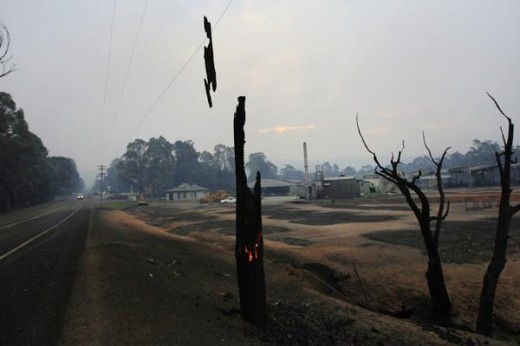
Out of the media frenzy to get ratings out of the Victorian bushfires, a ‘so-called’ bushfire expert on an ABC 730 Report panel (David Packham) advocated a 6 to 7 fold increase in prescribed burning for Victoria.
Another neo-Dreamtime wizard?
The effectiveness of this strategy is undermined by the live evidence shown (on ABC 730 Report Thursday 12-Feb-09) of local resident Jim Baruta in his home video. Over 200m of clear paddock stood between the bush and his house. This represents hazard reduction to an extreme degree (no trees or undergrowth for 200 m). Yet it was ineffective defence. Only his bunker saved his life.
As the ‘heat’ of the tragedy cools down, one of the overlooked impacts that needs to be considered in a balanced way is the impacts of broad scale fire (prescribed, wild, arson or otherwise) is having on the habitat of ground dwelling mammals. In the search for answers to avoid a repetition of the firestorm it is important that natural areas of high conservation value including old growth forests receive due recognition as natural assets worth protecting. Its integrity is not being measured and is probably disappearing through fire at a rate comparable to what logging is causing in SE Asia. That the bush grows back is not an indicator of its biodiversity health.
One must recognise that the bush (habitat) is also the innocent victim of these horrific fires. Dense ground cover is a fuel for fire but also home for wildlife. Keep removing the fuel and one removes the wildlife- eventually to its mass extinction. The underlying causes of the fires are the ignition, the lack of non-burnable material to create a buffer between good bush and human settlement, the slow detection of ignitions, the slow response to these while still manageable (remote country or otherwise) and the inadequate resources to suppress many spot fires. As to the ignition cause being arson – Australia needs a serious permanent criminology unit dedicated to this crime. The media and our leaders need to be careful not to incite dormant serial arsonists – just like one read and watched in the days preceding the first arson attack at Delburn on 29 Jan. The media frenzy just fuelled the copy cats’ excitement.
Bushfire management is a complex issue, so poorly under resourced, so poorly disconnected from bushfire research, yet so integrated into the lives of so many Australians. The public deserve a say into the Royal Commission. Those who tragically died and lost everything deserve billions not just in recovery but in the whole task of bushfire management.
.
.
Comments:
.
Re: Prescribed burning
April 17th, 2009 by ‘Matthew’:
.
I don’t doubt your commitment to the environment, but you’ve got it exactly backwards. Increased burning is exactly what we need. Not just for human safety, but because the Australian ecology depends on fire at the very least as a means of recycling dead matter (The Australian ecology is different from many others in that our lack of water tends to inhibit microbial decomposition – as a result fire takes on that role).
There are many other reasons, as well. The natural adaptation of Australian plants to fire means that fire suppression actually helps drive native species to extinction, as they are out-competed by faster growing, more prolific seed spreading imported weeds. This is often accompanied by native animals being pushed out in the same fashion.
But the weeds, by putting their effort into spreading widely, have few resources left to recover from periodic annihilation events (like bushfires), meaning that where the bush burns periodically, native plants and wildlife have a natural advantage. Strange as it may sound, continual fire protects native species.
So long as the fires are not the huge events that just happened, of course. Continual small fires (such as aboriginals lit – look up “firestick farming”) has proven to be best. This is not to say that exactly the same areas should be burned each time, of course.
An early paper of Tim Flannery’s on the subject would be a good introduction to the historical importance of fire, and how it relates to the rest of the Australian environment – please don’t be put off by the windy title: “The Timing, Nature, and Aftershock of Pleistocene Extinctions in Australia” (^http://www.amnh.org/science/biodiversity/extinction/Day2/bytes/FlanneryPres.html)
.
.
Lies, damn lies, and bushphobic myths
April 19th, 2009 by Tigerquoll:
.
Burning native habitat is State-sanctioned arson. If not, then perhaps Matthew in his claims above can offer verifiable ecological authority behind the myths he relies upon to justify why deliberatly setting fire to native habitat is ‘good’ for it?
.
Myth 1: “Increased burning is exactly what we need.”
Arsonist profess this, so how do you differentiate yourself? Arsonists feel good about lighting fires.
.
Myth 2: Bushfire is “good for human safety.”
Ambit claims deserve no more than single words rebuffs like: ‘crap’. But politely, I offer a more reasoned response.
Many prescribed burns actually get out of control and become the threat to human safety they are trying to avoid. Human safety is about not building in bushfire prone areas and not using materials that burn. Why is this logical solution avoided? If you choose to build in the bush and then burn the bush so that there is no bush around to burn, have you ust defeated your purpose of building in the bush? Bushfires burn down houses mainly fronm ember attack which can travel by winds many kilometres, so to remove the threat of ember attack, how many kilometres circumference of bush do you need to destroy to feel safe – 3km, 10km? You may as well build you house on farm land with no trees, undergrowth or grass in sight. Then you may be safe from ember attack. Think of the St Andrews example during the February Victorian Bushfires.
Bushfire fighting is all about rapid detecton, response and suppression of ignitions. Currently most bushfires are detected by thoughtful members of the public calling 000, then volunteers are called in and drive out in fire trucks. What are the performance statistics for say 2008 for all ignitions in Victoria in terms of elapsed time between estimated ignition time and response on site? Hours? Days? Such delays are not good for human safety or habitat.
.
Myth 3: “Australian ecology depends on fire”
Another ambit claim and so I say, crap. Name your ecological authority? Name species of flora that are threatened with extinction due the lack of fire? Name species of fauna that are fire dependent and relish being burns victims and displaced for years due to habitat destruction by fire?
.
Myth 4: “The natural adaptation of Australian plants to fire means that fire suppression actually helps drive native species to extinction, as they are outcompeted by faster growing, more prolific seed spreading imported weeds. This is often accompanied by native animals being pushed out in the same fashion.”
.
So you are now claiming bushfires are good because weeds grow faster than native plants. How is putting out bushfires logically connected to weeds? I am being really patient now.
Some Australian flora have become more fire tolerant that others, but others remain sensitive to fire and vulnerable to fire. This generalist claim disregards the complexity of biodoversity. It’s like claiming the bush growns back and so must be ok. Again, what ecological authority do you base you claim?
How does putting out bushfires (fire suppression) “drive native species to extinction”?
Weeds do not invade undisturbed bush easily – there is too much bush in the way. Heavy rain after burning will leave exposed subsoils and attracted weeds, but bushfire authorities who engage in prescribed burning abrogate themselves of responsibility for follow up weeding – ‘not our problem’ they say.
.
Myth 5: “Strange as it may sound, continual fire protects native species.”
Really strange this one. What ecological source, evidence, location do you have for this claim?
..
Myth 6: Aboriginal firestick farming has proven to be best.
Small mosaic occasional fires have prevailed across Australia, but the frequency and scale of that applied since 1788 has been a thousand fold – hardly comparable. Now we have a fraction of the good bush left, so hardly a comparable practice when we only have islands of the original natural landscape left.
Referring to Tim Flannery’s book is a start as a source, but what argument are you drawing upon? Name dropping is not supporting evidence.
Matthew, here’s some an ecological authority to counter your myth that ‘fire stick farming’ is an age old environmental condition “best” for the Australian bush.
“Professor Gell has uncovered evidence that the incidence of fires increased dramatically with the arrival of Europeans after the 1830s. Contrary to conventional beliefs, he says, the first squatters burnt the land far more regularly than Aborigines ever did.” [Source: “Researcher questions fire strategy” by Geoff Maslen in the SMH of 23 Mar 09, ^http://www.theage.com.au/national/researcher-questions-fire-strategy-20090323-96e2.html]
One must recognise that the bush (habitat) is also the innocent victim of bushfires, so how can you argue fire is good when the bush burns and by burning is killed, habitat lost and native animals burned alive, displaced because home ranges of native mammals are not transportable?
Think of a ‘home range’ like a farm dog chained to a tree – it can’t just walk to the next hill to escape fire. Home ranges are geographically fixed. Fire destroys them and the animals do know to move elsewhere. They may roam to feed but return to their burnt out home after feeding – exposed and so many die. I can cite evidence if you want.
Simplistic myths trying to generalise bushfires being good for Australia’s native flora and fauna are overdue their time of reckoning. Bushfire authorities simply are flying blind with no ecological idea of what they do.
The CFA in Victoria and RFS in NSW have become more adept at letting remote fire burn millions of hectares of native habitat and to lighting prescribed burns systematically every year, to the extent that bushfirefghting has forgotten its core task of bushfire suppression and supplanted it with prescribed burning.
This is defeatist. Perhaps the CFA now stands for Country Fire Arsonists and the RFS stands for Rural Fire Starters?
Notably not a Australian native zoologist among them.
.
.
Researcher questions fire strategy‘
by Geoff Maslen [March 23, 2009, The Age, http://www.theage.com.au/national/researcher-questions-fire-strategy-20090323-96e2.html]
.
A leading bushfire researcher has questioned calls for more frequent controlled burn-offs, saying they may make our forests more prone to large blazes.
The director of the centre for environmental management at the University of Ballarat, Professor Peter Gell, says frequent burning of Victoria’s forests may have resulted in bushfires becoming more frequent and more intense. Professor Gell has uncovered evidence that the incidence of fires increased dramatically with the arrival of Europeans after the 1830s.
Contrary to conventional beliefs, he says, the first squatters burnt the land far more regularly than Aborigines ever did.
“This may have created a situation where the frequent burning of forests early on changed the plants on the forest floor to create fire-provoking vegetation rather than reducing it.”
Professor Peter Gell is convener of a national network of scientists examining the affects of humans on Australia’s ecosystems. He also heads an international network of researchers on the effects of people on the world’s lakes
“At Ballarat, we are looking at fire history and we believe the incidence of fires markedly increased after Europeans arrived. The first squatters burnt more regularly than the indigenous people and might actually have increased the interaction between fire and vegetation rather than reduced it.”
Victoria’s early settlers turned most of the original forests into woodland and most of the woodland into grassland, Professor Gell says. So although the total “fuel load” has decreased, conditions for bushfires within the remaining forests are different now than they were 300 years ago.
“If we are facing a new climate and increasingly extreme and catastrophic fire hazards, fuel reduction burning may be doing little to restrict the passage of fires,” he says.
“It’s also possible that fuel reduction burning will become so frequent or excessive that biodiversity is completely sacrificed because the shrub layer that is critical for most of our rare and endangered birds and animals will be destroyed.”
Professor Gell says that governments are investing enormous sums of money in trying to maintain biodiversity, soil stabilisation and water quality. But these are all negatively affected by regular burning.
“If you burn every year or two, you could be throwing the baby out with the bathwater.” .
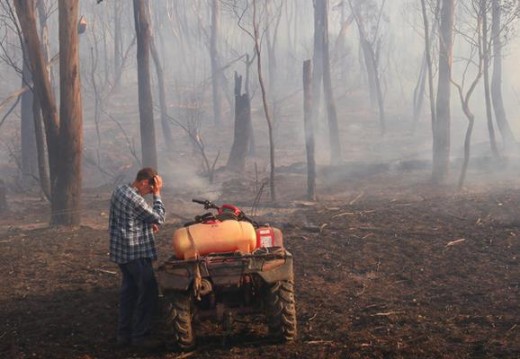
.
– end of article –
Tags: 1939 Black Friday Bushfires, bushfire fighting promise, bushphobic, duty of bushfire fighting, fire dependent, fire suppression, fire-provoking vegetation, firestick farming, fuel reduction burning, prescribed burning, save our forests, Threats from Bushfire, Victorian Bushfires 2009
Posted in Threats from Bushfire | No Comments »
Add this post to Del.icio.us - Digg
Saturday, July 16th, 2011
This article initially posted March 26th, 2009 on CanDoBetter.net by Tigerquoll
.
The Australian Institute of Criminology reported last month that half of Australian bushfires are deliberately lit. Bushfire research needs to go further to evaluate whether in fact of the most damaging most are deliberately lit.
Test: If one excluded arson ignitions and their related spotover fires (between 29 Jan at Delburn to 8 Feb) would the firestorms have occurred?
Assuming the answer is no, then clearly arson must be Australia’s key focus in combating the impacts of bushfire.
Unlike the other two causes of bushfire, (lightning and accident) which are random, bush arson targets the worst conditions, upwind of a specific target and often involving multiple ignitions.
The term ‘fire bug’ is too docile and to start seriously dealing with it, we must change the perception and the language. Bush arson has become so deadly and catastrophic a crime that it warrants the term ‘pyroterrorism‘. See the application of this term in the recent California fires.
^http://www.lilith-ezine.com/articles/thepyroterroristsarecoming.html
The forthcoming Royal Commission into the Victorian Bushfires of 2009 risks concluding similar theme recommendations as the 2004 COAG Enquiry into the 2003 Canberra Firestorm, which itself repeated those of many previous bushfire enquiries. The implementation of any recommendations requires budget, timeframe and an independent federal watchdog accountable to the public. I will be analysing its terms of reference.
Aside from serious resourcing of bush fire fighting (nationalising it, building approvals, building codes, etc), the key systemic problem is the cultural disconnect between bushfire research and fire fighting practice. Criminal arson investigation needs to be a permanent and dedicated arm of bushfire management, properly resourced with primary data collected from all Australia and overseas using the best criminal psychologists and with a proactive mandate.
In NSW, the government set up Strike Force Tronto to investigate serial bush arsonist after the Christmas 2001 bushfires. Then the government got complacent, other priorities emerged and it was disbanded in 2005. But following a series of arson bushfires in 2006 (with houses lost in (Picton and Cattai) the force was reinstated on 26 Sep 06 (Daily Telegraph p1). Reactive sporadic resourcing of bush arson investigation clearly isn’t effective.
To seriously address the main cause of deadly bushfires, a national organisation needs to be permanently established and perpetually funded to focus on criminal investigation into bush arson/pyroterrorism with a mandate to recommend deterrent policies and practices across Australian bushfire fighting as well as the media.
Media reporting leading up to the 7-Feb-09 firestorms, simply incited dormant serial arsonists. Go back and read The Age and television media in the days before and after 29 Jan when the first bush arsonist struck at Delburn (south wast of Churchill). The front page of The Age on Saturday 7-Feb-09 read: ’44 degree heat “as bad a day as you can imagine”
– which was a quote from of all people the Victorian Premier made to the general public the day prior.
Just like the media policy of not reporting suicides due it being known to encourage copy cats, so too media reporting of heatwaves and of extreme bushfire conditions needs to be tempered to avoid inciting dormant serial arsonists.
________________________________________
This was a submission to the ABC TV Four Corners programme on the Victorian Bushfires ‘Two Days in Hell’ by reporter Quentin McDermott, ahead of it being aired Monday 16-Feb-09.
Tuesday, July 12th, 2011
Article by Tigerquoll initially posted on CanDoBetter.net on 20090226:
.
.
The Fire was nearly out..so why was it abandoned by bushfire management?
The 2009 Wilsons Promontory bushfire was reportedly sparked by lightning striking the remote Cathedral Range on the east coast just north of Sealers Cove on Sunday 8th February 2009.
Witnesses say that by the following Friday 13th, the fire was still localised on the Range and all but out. This is confirmed by the following satellite photo taken by NASA’s MODIS Rapid Response Team on the 13th. The satellite takes high-resolution images of visible, shortwave and near-infrared light of Victoria twice daily.
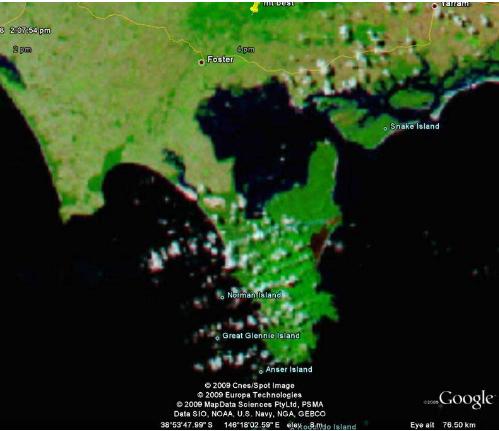 Wilsons Promontory on 13th Feb 2009
showing scattered cloud over the Prom and on the east coast (right side) a small red (burnt) patch with only a single column of smoke noticeable.
© NASA 13-Feb-09
. Wilsons Promontory on 13th Feb 2009
showing scattered cloud over the Prom and on the east coast (right side) a small red (burnt) patch with only a single column of smoke noticeable.
© NASA 13-Feb-09
.
Daily updates of this fire can be found at the following URL:
http://www.nasa.gov/mission_pages/fires/main/world/australiafire_20090223.html
.
The Prom was left to burn
Over the subsequent days the fire continued to burn then the winds increased. Now, more than two weeks later most of the northern half of ‘the Prom’ has been burnt. The vegetation has gone. The Victorian Country Fire Authority (CFA) website today reports 23,800 hectares burnt out. The Department of Sustainability and Environment (DSE) website shows the following map of the burn (shaded area below).
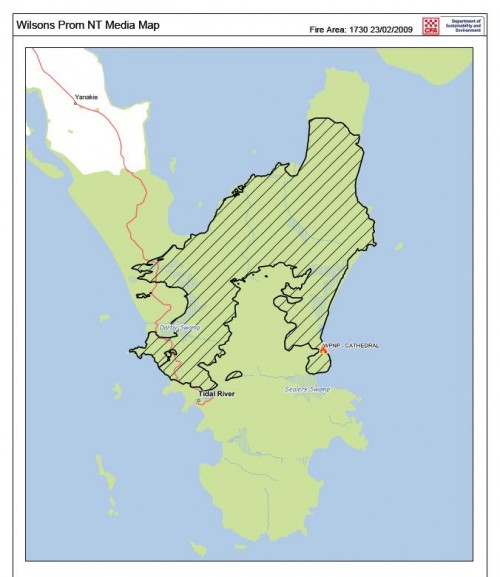
© DSE Wilsons Promontory Media Map 24 Feb 09 12:30pm
.
The fire has burnt the Cathedral Range, along the east coastline right across and along the Corner Inlet shoreline to Millers Landing. Affected sites are Vereker Creek, Whiskey Bay, Tongue Point, Monkey Point, Three Mile Point, Mt Roundback, Three Mile Beach, Mt Margaret, Lighthouse Point Lighthouse, Mt Hunter and parts of Darby Swamp. Wilsons Promontory National Park is just one of the many important natural and wilderness areas of Victoria devastated by these current bushfires.
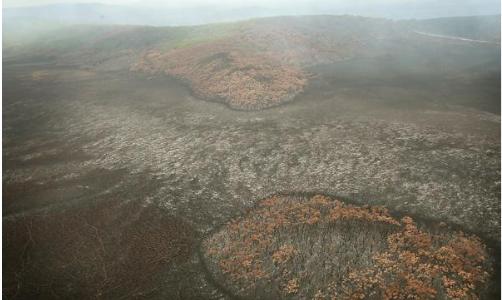 Wilsons Promontory where thousands of hectares have been burnt
© Photo. John Woudstra 18-Feb-09 Wilsons Promontory where thousands of hectares have been burnt
© Photo. John Woudstra 18-Feb-09
.
Frequent Fire History
In the case of the Prom, this is the second time in four years that fire has burnt through this northern region. On 21 March 2005, a twenty hectare prescribed burn was lit east of Tidal River. It escaped three times over a period of twelve days and burnt out 6,000 hectares of native bushland in the National Park.
A key investigative report was undertaken by Commissioner, Emergency Services, Bruce Esplin, (the Esplin 2005 Report) into a number of fires over previous years. In the case of this DSE prescribed burn in the Prom, the investigations found that the prescribed burn was poorly planned and after ignition, was not patrolled properly.
A notable finding of the report was that: “There remains considerable community uncertainty about the effectiveness of the prescribed burning program, and what changes, if any have occurred in the amount of prescribed burning undertaken since 2003”.( para 33)
Yet prescribed burning continues each year across Australia, not in the small mosaics, but on a grand scale and with a record of frequently getting out of control. On top of the 6,000 hectares four years ago, just a few days ago we hear of over 23,000 hectares of the Prom has now been burnt. Fires in the Prom also occurred in 2001.
.
Impacts on Flora and Fauna
The Prom has diverse vegetation communities including warm temperate and cool temperate rainforest, tall open forests, woodlands, heathlands, and swamp and coastal communities. There are rare stands of White Mangrove, being the most southerly stands of mangroves in the world.
The Prom is rich its diversity of native mammals with over thirty species having been recorded, many of which are either rare or threatened. These include the Long-nosed Potoroo, Swamp Antechinus, White-footed Dunnart, Broad-toothed Rat, Feather-tailed Glider and Eastern Pygmy-possum. “One of the most significant habitats of the New Holland Mouse also occurs within the park, and a number of species of whale have been sighted in the waters off its coastline.” The Prom also provides habitat to populations of Eastern Grey Kangaroos, koalas, wombats and emus.
The heathlands, influenced by the frequency and intensity of fire, are rich in species and provide habitats for a variety of fauna, including many threatened species. [Source: Parks Victoria website]
However, bushfire research across Australia has shown that while some native flora are fire tolerant and/or can recover and in some case thrive in the immediate years following a fire, other species have not adapted and so they become displaced and can die out. (DSE website).
While the Victorian Royal Commission is focusing on the fire management measures to protect life and private and public property associated with the 2009 Victorian Bushfires, the impacts on flora and fauna seem to have been overlooked. Some species may not survive if fires are too frequent, as the plants are unable to reach maturity and produce sufficient seed before the next fire episode. (DSE website).
.
Threatening Process
Little is known about the recovery of fauna diversity as a consequence of such widespread bushfires, be they caused by lightning, intentionally or otherwise. But given the scale of these current fires across the Prom crossing from shore to shore, it is probable than many native animals, as in many other parts of Victoria, will have been burnt alive in the fires and that their already rare populations will now have declined substantially and be at risk of local extinction.
In respect to Australia’s fauna, given that there we now have a fraction of the intact native habitat compared with pre-1788, how can anyone argue that allowing bushfires to get out of control is not a threatening process?
.
Saturday, January 1st, 2011
 The Bush Arsonist The Bush Arsonist
© Photo by William Haun, whaun.com, http://www.whaun.com/
.
Once again in the lead up to Christmas in Australia, State governments and their media PR cohorts remind us of “extreme temperatures”, “low humidity”, “forecast high winds”, “declared total fire bans” and even “catastrophic bushfire conditions”.
.
So what’s new? – hot Australian Summers are not really newsworthy.
Perhaps to create news, readers were again stirred with the fear and dread of bushfire risk and reminded of previous Summer bushfire catastrophes – “State Warned of heatwave and black Christmas” (Sydney’s Daily Telegraph page 1 headline, 23-12-05].
But media talking up bushfire risk must surely stir dormant bush arsonists, as if overtly tempting drugs to addicts?
.
Take the following newspaper quotes of recent days (SMH, AAP, Telegraph):
- “It will be a bad fire day with the wind hitting late afternoon in Sydney and moving up to Port Macquarie with a bang on Saturday night.”
- “The worst is yet to come”
- “Essentially, now any fires that might start would be very very hard to bring under control.”
- “Authorities fear scorching temperatures.. will fuel further fires.”
- “The weather is providing perfect firestorm conditions.”
.
…like a red rag to a bull.
Then sure enough, starting from Christmas Eve (with no reported lightning) we hear of the spate of bush fires started across NSW, of multiple ignitions forming into a fire front near Woy Woy, a suspicious grass fire next to the old Canberra brickworks, and of many other bushfires across NSW and interstate.
Long respected is the media code of ethics not to report suicide deaths because experience has sadly shown that such publicity encourages copy-cats.
Yet invariably each year preceding Christmas, some media stir up this supposedly ‘inevitable’ bushfire threat. Such emotive language risks fuelling serial arsonists, drawing recidivists out of hibernation to prove media forecasts correct.
Arsonists read newspapers. The media are part of the solution – headline the convictions not their crimes.
.
[This letter by the editor was first published in the Blue Mountains Gazette 20060118.]
Tags: arson, arson media incitement, Black Saturday, bushfire arsonist, bushfires in Australia, forest fire, media responsibility, Reduce Deliberate Bushfires, serial arson, stir dormant bushfire arsonists, Threats from Bushfire, Victorian Bushfires Royal Commission
Posted in Threats from Bushfire | Comments Off on Arsonists Read Newspapers
Add this post to Del.icio.us - Digg
Tuesday, December 21st, 2010
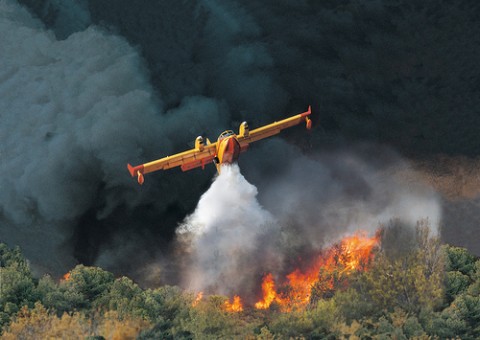 Bombardier 415
“This amphibious aircraft is the backbone of firefighting missions around the globe. Launched in 1994, this high-wing, all-metal amphibian remains the only aircraft specifically designed for aerial firefighting. Its proven technology and fire-extinguishing power make it the most effective machine for the job.”
Photo: ©1997 Bombardier Aerospace. http://www.aerospace-technology.com/projects/bombardier_415/images/415_1.jpg Bombardier 415
“This amphibious aircraft is the backbone of firefighting missions around the globe. Launched in 1994, this high-wing, all-metal amphibian remains the only aircraft specifically designed for aerial firefighting. Its proven technology and fire-extinguishing power make it the most effective machine for the job.”
Photo: ©1997 Bombardier Aerospace. http://www.aerospace-technology.com/projects/bombardier_415/images/415_1.jpg
.
A proven effective strategy against bushfires is early detection and response to ignitions.
Suppressing and ignition before it spreads seems logical enough, although perhaps with existing Rural Fire Service (RFS) is easier said than done. But is funding, and are RFS ‘fuel management’ strategies focusing on this albeit logical fire-fighting solution?
The Blackheath Glen wildfire (reportedly lit by bush arsonists, unconvicted) that started on 13th December 2002 was confirmed as having spread over 13 kilometres in less than six hours. By simple calculation the fire was travelling at less than 3kph. Why was it not detected early and suppressed?
Bushfire ignitions should be responded to before growing into uncontrollable wildlife fronts. Relying upon phone calls from the public to ‘000’ shouldn’t be a main detection mechanism, especially during times of known extreme bushfire (arson) risk.
Constant monitoring of bushfire prone bushland during the high risk season is crucial if we are serious about early detection. These days we have sophisticated long-range digital video cameras, radar and real-time satellite infrared cameras that can pick up individual trees! Perhaps the RFS should also have dedicated airborne fire surveillance crews. As for operational response, are fire crews sited in the most strategic response locations 24/7 on standby?
Is bushfire modelling and are the fire history databases utilised to allocate crews strategically to vulnerable and probable ignition locations? Stand-by helicopter air cranes equipped with water bombing capability provide faster response and superior access than truck-based crews.
Such solutions exist, yet require sophisticated resources, management and cost millions.
We choose to build closer to the bush, but are we serious about protecting lives and million of dollars worth of property from bushfire? Can we afford to rely on a grant and raffle-funded volunteer force or is it time to evolve the RFS into a specialist division of the NSW Fire Brigade and seriously resource it?
[This letter by this editor was first published in the Blue Mountains Gazette, 7th December 2005 on page 10]
.
.
Reader feedback to this letter at the time:
.
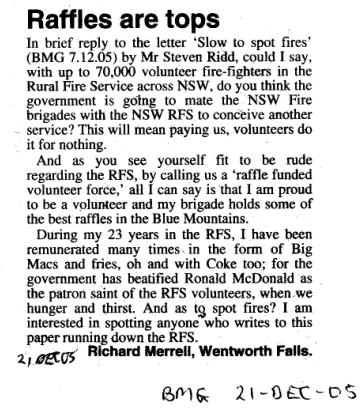
Friday, August 20th, 2010
by Editor 20100820.
Following the devastating Grose Valley bushfires of November 2006 in New South Wales (Australia), which burnt out 14,070 hectares of high conservation bushland in and around the Greater Blue Mountains World Heritage Area, the editor (a nearby resident and witness) wrote to the head of the NSW Rural Fire Service.
The letter raised serious concerns about bushfire management and offerred constructive recommendations and a detailed operational reform initiative. The letter was not responded to by the Rural Fire Service.
[Read below]
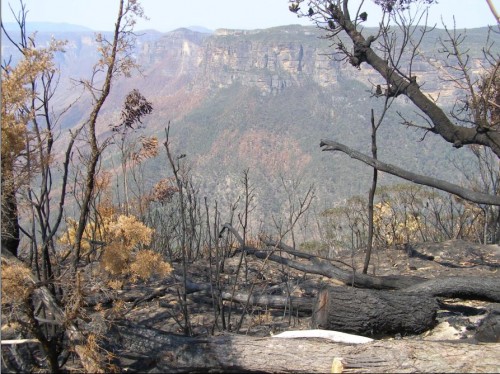
Aftermath of the Grose Valley Bushfires, Blue Mountains, NSW (Australia)
looking from Govett’s Leap, Blackheath.
[Photo taken 9-Dec-2006]
The Habitat Advocate
PO Box 21
KATOOMBA NSW 2780
Wednesday, 9th January 2007
Mr Keith Harrap
Assistant Commissioner
NSW Rural Fire Service
15 Carter Street
HOMEBUSH NSW 2127
Dear Mr Harrap,
Your Ref: M07/0515
RE: FOI Request for Operational Reports & Costs of the Grose Fire
Thank you for your reply letter of 24-Dec-07. I appreciate the efforts of your staff to search and to try to provide this information that I have requested about the operational reports and costs directly associated with the Grose Fire of November 2006. I am particularly grateful for the co-operative communication provided by Justin Walsh at NSW Rural Fire Service (RFS) headquarters.
I have some questions about the information provided in respect to the RFS recording of events and costs associated with this major fire. I wish to also offer some observations and make recommendations that I will appreciate you taking on board by way of ongoing quality improvements to fire management policy and practices. In this regard, I have had some brief communication with the local Superintendent District Manager of the RFS in the district where I live (the Blue Mountains), Mal Cronstedt.
Mal Cronstedt as you will be aware, was the Incident Controller of the Grose Fire. As courtesy I shall send him a copy of this letter as well as the information you have provided me. I will also appreciate you passing on a copy of this letter to the NSW RFS Commissioner, Mr Shane Fitzsimmons and advise that I will also welcome his feedback.
Fire Incident Recording
I am surprised by your reply that the RFS does not have any record or minutes of the operational meeting immediately following the Grose Fire. The reported inter-agency review that took place at Katoomba on 19th December 2006 some three weeks after the fire would have included critical operational information about the Grose Fire. The accurate hands-on operational feedback from fire fighters would have proved invaluable in preparing the formal Section 44 Incident Controller’s Report into this fire. Such operational information, feedback and assessment would be invaluable in providing increased understanding of the fire incident and fire behaviour, of resource utilisation and of management handling and decision making during the fire.
This would support fire investigation efforts and facilitate analysis of the fire and of fire fighting performance and effectiveness. It would be a valuable addition to the wealth of strategic and operational fire knowledge to the local fire command to help them take remedial actions to improve fire management standards and resourcing.
However, without any operation records of this major fire incident such benefits have been lost.
I have asked Justin Walsh at RFS headquarters to also find out if any reports or meeting minutes exist by either Fire Captains at Katoomba or Lithgow from where the fire fighting of the Grose Fire was jointly controlled. If such information exists then I shall be applying for an additional Freedom of Information request for this.
Given the considerable monetary cost of this fire, the extensive resources required to combat it and bring it under control, the wide media attention it attracted and the public outcry as a result of the damage to the Blue Gum Forest, it would seem inconceivable that no records, field notes or daily records exist about the fire’s progress and of decisions and actions taken by fire management.
If so, this suggests a serious disconnect between executing fire suppression operations and monitoring those operations. This surely would undermine performance management planning and review systems within the RFS. It sends a message to the community that the RFS is not accountable.
As you will be aware, under the RFS Corporate Plan 2007-2009, a key value includes ‘continuous improvement’ which it applies on page 14 to being “we pro-actively seek, develop and implement benchmarks, to measure, monitor and improve our performance.”
RFS Key Strategy Programme 1.1.5 under this plan reads:
“Maintain an accurate system for the recording of all fire and emergency incidents using the Fire Incident Reporting System (FIRS) by reporting all incidents to the Operations Customer Support Centre.”
RFS Key Strategy Programme 1.1.33 under this plan reads:
“Continuously improve the effectiveness and efficiency of the Service’s business and tactical planning by reviewing, maintaining and improving the Service Delivery Model (SDM).”
I have concerns that this plan is not transferring into practice.
Recommendation:
Last month I outlined to Mal Cronstedt a recommended reform initiative ‘Compulsory Fire Event Logging’. This reform initiative proposes to standardise and make compulsory a Bushfire Event Log for every registered fire in New South Wales. This would seek to capture all quantitative and qualitative information about a fire. The purpose of a Fire Event Log would be to capture and consolidate all information associated with combating a fire into one document for operational analysis and future reference use.
I look forward to Mal’s feedback on this recommended reform.
Total Fire Cost
The expenditure summary that you have provided seems to be an internal RFS accounting report limited to the direct recorded outlays of the RFS associated with the Grose Fire.
However, my Freedom of Information request is for the total cost of the Grose Fire – the ‘Total Fire Cost’. By this I am referring to all expenditures and costs incurred by the RFS and all associated organisations involved directly and indirectly in fighting this fire, including asset loss valuations. The direct and indirect costs that I expect can be attributed to the fire, would include:
- Direct and indirect operating costs incurred by the RFS from the time of first responding to the fire through to completing mopping up operations after the fire was extinguished
- Direct and indirect operating costs incurred by all fire fighting authorities fighting the fire including NSW Rural Fire Service (RFS) – both local and Inter-District, NSW Fire Brigades (NSWFB), Department of Environment & Conservation (NSW) – (NSW National Parks and Wildlife Service (NPWS)).
- Direct costs incurred by organisations associated with fighting the fire such as the many interstate support agencies seconded to fight the fire, including their associated transport and accommodation costs, plus the costs of other support organisations which can directly attribute costs specifically to this fire. Support Agencies listed in the Section 44 Report section 4.2 include the following:
- Any direct operating costs of the fire not paid for by the RFS due to funding, subsidies or rebates provided by government agencies outside the RFS.
- Direct expenses of related injury and accident claims of personnel directly involved in fighting the fire, including the cost of WorkCover claims, related payouts and lost time at work.
- Economic loss valuations of property, plant and equipment damaged as a direct result of the fire. This includes those of owners of land and infrastructure such as DECC, Blue Mountains City Council, RailCorp, Sydney Catchment Authority, Integral Energy, Telstra, the NSW Roads and Traffic Authority and private land owners, including insurance claims.
-
- Ambulance Service of New South Wales
- Blue Mountains City Council (BMCC)
- Department of Defence, Royal Australian Air Force (RAAF)
- Integral Energy
- NSW Department of Community Services
- NSW Department of Land and Water Conservation
- NSW Department of Primary Industries
- NSW Health
- NSW Police Force
- NSW State Emergency Service (SES)
- Roads and Traffic Authority, NSW (RTA)
- Rail Corporation New South Wales (RaiICorp)
- Salvation Army
- St Johns Ambulance of Australia
- Sydney Catchment Authority (SCA)
- Sydney Water
- Telstra Corporation Limited
This list is not exhaustive.
Importantly, here I am not seeking to obtain the broader social and environmental costs, which though relevant, would understandably be more difficult to estimate and obtain. Instead, I am merely seeking those accounting costs that can be reasonably and justifiably attributed to this fire. Such costs must be recorded respectively by each organisation as part of Australian financial accounting practices.
Does the RFS have access to these costs? Does the RFS maintain a database that captures all direct and indirect costs of each major bushfire in NSW? If not, does the RFS have any plans to start capturing Total Fire Costs of major fire or indeed to capture the Total Fire Costs of each registered fire incident during each financial year?
Recommendation:
I propose that the RFS should capture the Total Fire Costs for each major fire and, to be comprehensive, for all registered fire incidents to which the RFS responds. The expertise for this task may well require the assistance of an outside audit firm.
However, the benefit of this to the RFS and to the community will be considerable in highlighting the Total Fire Costs of fighting fires in New South Wales, which I argue we still don’t know with any reliably accuracy. I expect that for the Grose Fire for instance, the Total Fire Cost will be a considerably larger figure than the internally recorded accounting records of the RFS of $6.1 million.
Such record keeping will serve to greatly assist the effort of the RFS to attract increased funding to enable it to better:
- mitigate the risk of bushfires
- resource itself to better detect ignitions
- resource itself to better suppress bushfires.
I understand that between 2003 and 2007 the Bushfire Co-operative Research Centre (Bushfire- CRC) with RMIT University completed a research project, which involved researching the ‘true costs of bushfires’. It would be useful to seek the reports from this project.
RFS Reporting of Fire Incidents
Please advise RFS policy and practice guidelines for recording major fire incidents? [Read recommended policy initiative below]
Recommendation:
As an RFS policy, that for each major fire incident declared under Section 44 of the Rural Fire Act 1997, I recommend that both an Incident Controllers Report together with the Total Fire Costs of Fire be provided by the RFS to the Minister for Emergency Services.
I will welcome your feedback and the opportunity to participate in reforms to fire management across NSW.
Yours sincerely,
[the Editor]
CC: Mal Cronstedt, Superintendent, District Manager, Blue Mountains
Rural Fire Management Reform
Recommended Reform Initiative #01
Compulsory Fire Event Logging
Table of Contents
1. Purpose of Reform Initiative
2. Recommended Policy
3. Recommended Procedures
4. Justifications for Reform Initiative
5. Benefits of Reform Initiative
1. Purpose of Reform Initiative
This reform initiative proposes to standardise and make compulsory a Bushfire Event Log for every registered fire in New South Wales.
The purpose of a Fire Event Log is to capture and consolidate all information associated with combating a fire into one document for operational and reference use.
Typical information about a fire is to be sourced from fire management decision-making, deployment instructions, radio communications from fire-fighting crews, observations by airborne crews, current weather statistics from the Bureau of Meteorology and relevant information received from other emergency services (NSWFB, Police, Ambulance, SES, etc) associated with a subject fire.
2. Recommended Policy
The Fire Control Centre of each Rural Fire District in New South Wales must establish and maintain a separate Fire Event Log of each registered fire occurring, either wholly or partially, within its Rural Fire District.
A minimum Australian standard of vital fire information necessary for a Fire Event Log must be established and approved by the NSW Rural Fire Service Commissioner. This standard must be reviewed annually ahead of each peak fire risk season.
A suitable training programme in Fire Event Log Procedures must be established to enable suitable fire personnel to be trained in order to competently maintain a Fire Event Log to the minimum Australian standard.
This policy should be integrated into the RURAL FIRE SERVICE Standard Operating Procedures once a process of consultation with all relevant personnel has been extensively undertaken across the entire breadth of the organisation.
Once approved, a Fire Event Log Policy and Procedures should be gazetted into the Rural Fires Act (NSW), 1997 and considered similarly for each fire authority in each Australian State.
3. Recommended Procedures
- The Fire Control Centre of each Rural Fire District across New South Wales must establish a new and separate Fire Event Log upon becoming first aware of any fire within its fire district.
- A Fire Event Log must be maintained continuously throughout the duration of a fire within a Fire District until such time as the responsible Fire Control Officer (or higher RURAL FIRE SERVICE command) declares the fire extinguished within that district.
- A Fire Event Log must be recorded using the RURAL FIRE SERVICE central computer system, with appropriate daily data back ups generated at the end of each day.
- The Fire Control Officer for a given Rural Fire District is ultimate responsibile and accountabile for establishing and maintaining an accurate and thorough Fire Event Log for each fire in its district. A Fire Control Officer may only delegate the task of maintaining a Fire Event Log to a qualified fire fighter holding a current endorsement in Fire Event Log Procedures.
- The Fire Control Officer of each Rural Fire District must endeavour to capture all information about a fire in a separate Bushfire Event Log for each fire (where possible) including, but not limited to
- The designated name of the subject fire
- Date & time of the ignition
- Location of the ignition
- Cause of the ignition
- GIS digital map updating of the fire spread, likely path and key data
- Details of the initial reporting of the fire outbreak/detection details
- Lapse time to initial response & details of initial response action
- Location of fire(s) & fire behaviour updates at 15 minute intervals
- Local and forecast weather statistics relevant to the fire
- Interstate agencies seconded
- Daily updates on Total Area Burnt
- Daily updates on any lives Lost
- Daily updates on property lost, including number of dwellings
- Daily updates on area of private property & farmland burnt
- Daily updates on areas of mapped high conservation areas burnt
- Daily updates on the number of fire-fighters involved
- Daily updates on the number of aircraft involved
- Daily synopsis on the fire(s) status
- Executive decisions and actions taken, including incident declaration
- Critical issues
- Key operational threats & risks
- Fire resource needs and shortfalls
- Contact details and correspondence with assigned fire investigation
- Total duration of fire activity once extinguished
- Injury Summary Report
- Resource Usage Summary Report by contribution agency
- Register of Support Agency Involvement
- When a fire takes the form of combined fires or multiple fire fronts within reasonable proximity in a geographic area, the responsible Fire Control Officer may order that a single Fire Event Log be maintained for the combined fires/multiple fire front.
- Regular communication must be maintained between the Fire Control Centre and field brigades fighting a fire to facilitate logging fire activity to a minimum standard that allows communications at a minimum interval of 15 minutes.
- Any communications failures or difficulties between firefighting crews (ground and airborne) and Fire Control, or any problems experienced in maintaining a minimum 15 minute communications frequency, must be immediately reported by the Fire Control Officer, or in the case of a major fire incident, to the Incident Controller.
- A Fire Event Log is to be deemed the official single register of a fire event, a core operational document and a legal document admissible in a court of law.
- As an internal document, a Fire Event Log is not automatically available for public access. The RURAL FIRE SERVICE Commissioner may at his/her discretion allow public access to such a document via a Freedom of Information Request from a member of the public.
- The integrity and security of a Fire Event Log is paramount and is the ultimate responsibility of the Fire Control Officer assigned to a given fire. A digital copy of Fire Event Log must be provided by a Rural Fire District branch to RURAL FIRE SERVICE Headquarters within 7 days of the fire being declared extinguished. A secure and accessible database of Fire Event Logs is to be maintained by both the respective Rural Fire District branch and for all fires across NSW by RURAL FIRE SERVICE Headquarters.
4. Justifications for Reform Initiative
- While it is acknowledged that the author is not a member of the Rural Fire Service and so not privy to Rural Fire Service policy and procedures for recording bushfire operations, the lack of operational detail provided the Section 44 Incident Controllers Report for the Nov-06 Grose bushfire and the absence of minutes from the subsequent Inter-Agency review on 19-Dec-06, highlight shortcomings in record keeping of fire operations.
- Perhaps much of the information reported of bushfire events is obtained from personal recollection of events from individual line personnel a considerable time after the event. For instance, the Section 44 Report into the Grose bushfire (14-Nov-06 to 3-Dec-06) is dated 8-Feb-07, two months later. There are obvious problems relying upon recollecting detailed events, the precise time and order of those events, the changing fire behaviour, the decisions made and actions taken and the changing conditions at the time. The absence of a factual minute by minute event log makes it difficult to be accurate and comprehensive in reporting major bushfire incidents. In the event of a major fire, maintaining a Fire Event Log will provide a record the performance of the four ICS functions – control, operations, planning and logistics.
- It may well be that bushfire agencies in each Australian state have their own methods and protocols for recording fire events. It may also be that different agencies and indeed different regional branches have their own different ways of recording bushfire event data. There is likely no universal consistent standard across Australia of recording bushfire events as they occur. Some records may be better than others. There is a need to have a consistently high standard of record keeping for bushfire events across Australia.
- Recent coronial inquests in Australia into bushfire deaths (Canberra Bushfire Jan 2003, Eyre Peninsula Fire Jan 2005), highlight the need for fire authorities need to have accurate records of bushfire events so that they are better able to defend their actions in court.
5. Benefits of Reform Initiative
- The benefits of establishing and maintaining a Bushfire Event Log is to better enable bushfire management to achieve an accurate and comprehensive record of a fire – the events, decisions and actions and outcomes associated with each fire event. All relevant operational data associated with a fire will be recorded in one convenient document.
- A Bushfire Event Log will provide a reliable source document for preparing a fire incident report. This will avoid the often difficult task of having to recall events, the order of those events, decisions made along with the fire behaviour at the time, long after a fire sometimes days or weeks later when memories have faded.
- Recent reports and inquests have highlighted failures in fire-fighting communications, which arguably had a role in contributing to operational problems in controlling the spread, severity and impacts of fires. Compulsorily requiring a Bushfire Event Log will require regular communication between fire-fighters and Fire Control. This requirement will help drive the need to improve the reliability of operational communications during a bushfire event.
- A Bushfire Event Log will provide a actual live record of the performance of the co-ordination, command and control functions of the ICS, including the operational sequence: Reaction, Reconnaissance, Appreciation, Plan, Issue of Orders and Deployment. This log will be highly useful at a debriefing session following a fire, allowing operational problems to be better identified. This will aid the RURAL FIRE SERVICE to increases its knowledge and understanding of rural fire fighting.
- A Bushfire Event Log will enable bushfire management to be more transparent in reporting its operations, assisting any possible coronial investigations, for operational evaluation and improvement, analysis and to contribute firefighting practice into bushfire research. By making fire event logging compulsory, regular information must be fed back to central command in order to achieve the minimum reporting standard. This will drive a higher standard in strategic communications.
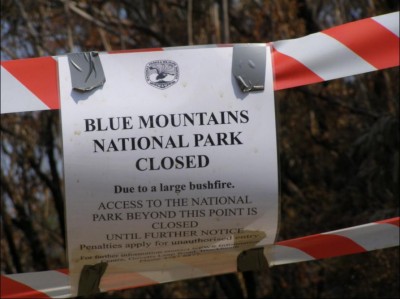
© The Habitat Advocate Public Domain
|
|



















